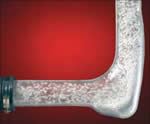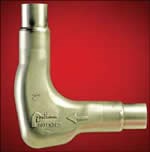Convey Pellets Around Corners Without Generating Dust and Fines
It's a common problem that goes by a lot of names: dust, fines, streamers, angel hair.
It's a common problem that goes by a lot of names: dust, fines, streamers, angel hair. The resin arrives at your plant with a guaranteed level of cleanliness from the resin supplier, but by the time it gets into your silo or machine hopper, it's contaminated with fine particles. They overheat in the machine barrel, causing bubbles, burning, and black spots.
The basic cause of the problem is well known: Pneumatic conveying systems drag pellets through piping on a stream of air moving at around 60 mph. When the pellets come up against a 90° bend, they hit hard, smearing and fracturing.
A number of types of "elbows" have been designed to reduce this problem, with some success, but fines and quality problems have not disappeared altogether. Now there's a new, patented approach based on research at the University of Pittsburgh into the aerodynamics of pellet flow. That research has produced the "Pellbow" from Pelletron Corp.
Slow down for the curve
The Pellbow briefly changes the pellet flow from dilute phase (low pressure, high speed) to dense phase (high pressure, low speed) and back again to dilute phase. This is accomplished by expanding and then contracting the cross-sectional area of the elbow. This accomplishes two things: First, the pellets slow down, but don't stop, while making the turn. Second, pellets don't hit the hard wall of the pipe in the turn—rather, they bump into a soft body of slow-moving pellets. As a result, there's much less wear on the elbow when running abrasive glass-filled materials. What's more, the Pellbow reportedly is 100% self-cleaning when the pipe system is purged.
Pelletron claims that the Pellbow virtually eliminates formation of fines and streamers in pipe elbows, though not in straight sections of pipe. As a rule of thumb, a standard elbow will produce as many streamers as 100 ft of horizontal pipe.
Early this year, Pelletron hopes to prove its claims through a scientific comparison with a standard elbow. Pelletron will use a new method it developed that can measure dust as small as 0.001 microns. This approach directs a high-velocity water spray onto pellets held on a screen. The water washes off the fines, which then can be weighed. This technique is being developed into a new standard test method for dust contamination by ASTM International, West Conshohocken, Pa.
The Pellbow is made of aluminum, 316 stainless steel, or a ductile iron casting. Prices are said to be in the middle range for elbows on the market.
More dust-busting news
Another recent development from Pelletron is its patented FlowEnhancer, a straight blow-off pipe section that is inserted into a pneumatic conveying line. It reduces the velocity of the conveying air while increasing the conveying capacity of the line, Pelletron claims. The purged air is filtered before it is released. The result is said to be less noise and fines and increased flow rates.
Related Content
-
Automated Resin Management and Blending System for Tight Spaces
NPE2024: Designed for new and existing operations with up to 10 machines and limited available space.
-
How to Effectively Reduce Costs with Smart Auxiliaries Technology
As drying, blending and conveying technologies grow more sophisticated, they offer processors great opportunities to reduce cost through better energy efficiency, smaller equipment footprints, reduced scrap and quicker changeovers. Increased throughput and better utilization of primary processing equipment and manpower are the results.
-
New Pump Rewrites Conveying Rules
NPE2024: Smart Pump technology brings more flexibility and finesse to resin conveying.

















